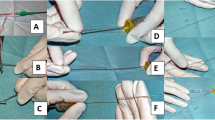Abstract
Radial artery occlusion (RAO) is the most common structural consequence of transradial access (TRA) with an estimated incidence ranging from 2-10 %. Its occurrence is free of any major clinical consequences, especially at rest, with most if not all cases of digital ischemia occurring as a result of embolization, rather than RAO. The incidence of RAO is unacceptably high if “best practices” are not followed. Strategies to prevent RAO need to be implemented to preserve radial artery patency in order to exploit other benefits of TRA.





Similar content being viewed by others
References
Papers of particular interest, published recently, have been highlighted as: • Of importance
Feldman DN, Swaminathan RV, Kaltenbach LA, Baklanov DV, Kim LK, Wong SC, et al. Adoption of radial access and comparison of outcomes to femoral access in percutaneous coronary intervention: an updated report from the national cardiovascular data registry (2007-2012). Circulation. 2013;127(23):2295–306. This important paper discusses adoption of radial access and compares outcomes of femoral access in PCI.
Bertrand OF, Bélisle P, Joyal D, Costerousse O, Rao SV, Jolly SS, et al. Comparison of transradial and femoral approaches for percutaneous coronary interventions: a systematic review and hierarchical Bayesian meta-analysis. Am Heart J. 2012;163(4):632–48.
Sanmartin M, Gomez M, Rumoroso JR, Sadaba M, Martinez M, Baz JA, et al. Interruption of blood flow during compression and radial artery occlusion after transradial catheterization. Catheter Cardiovasc Interv. 2007;70(2):185–9.
Pancholy SB. Transradial access in an occluded radial artery: new technique. J Invasive Cardiol. 2007;19(12):541–4.
Pancholy SB, Sanghvi KA, Patel TM. Radial artery access technique evaluation trial: randomized comparison of Seldinger versus modified Seldinger technique for arterial access for transradial catheterization. Catheter Cardiovasc Interv. 2012;80(2):288–91.
Spaulding C, Lefevre T, Funck F, Thebault B, Chauveau M, Ben Hamda K, et al. Left radial approach for coronary angiography: results of a prospective study. Cathet Cardiovasc Diagn. 1996;39:365–70.
Pancholy SB. Comparison of the effect of intra-arterial versus intravenous heparin on radial artery occlusion after transradial catheterization. Am J Cardiol. 2009;104(8):1083–5.
Plante S, Cantor WJ, Goldman L, Miner S, Quesnelle A, Ganapathy A, et al. Comparison of bivalirudin versus heparin on radial artery occlusion after transradial catheterization. Catheter Cardiovasc Interv. 2010;76(5):654–8.
Bernat I, Bertrand OF, Rokyta R, Kacer M, Pesek J, Koza J, et al. Efficacy and safety of transient ulnar artery compression to recanalize acute radial artery occlusion after transradial catheterization. Am J Cardiol. 2011;107(11):1698–701.
Saito S, Ikei H, Hosokawa G. Tanaka S Influence of the ratio between radial artery inner diameter and sheath outer diameter on radial artery flow after transradial coronary intervention. Catheter Cardiovasc Interv. 1999;46(2):173–8.
Pancholy S, Coppola J, Patel T, Roke-Thomas M. Prevention of radial artery occlusion-patent hemostasis evaluation trial (PROPHET study): a randomized comparison of traditional versus patency documented hemostasis after transradial catheterization. Catheter Cardiovasc Interv. 2008;72(3):335–40.
Cubero JM, Lombardo J, Pedrosa C, Diaz-Bejarano D, Sanchez B, Fernandez V, et al. Radial compression guided by mean artery pressure versus standard compression with a pneumatic device (RACOMAP). Catheter Cardiovasc Interv. 2009;73(4):467–72.
Pancholy SB, Bertrand OF, Patel T. Comparison of a priori versus provisional heparin therapy on radial artery occlusion after transradial coronary angiography and patent hemostasis (from the PHARAOH Study). Am J Cardiol. 2012;110(2):173–6.
Rao SV, Tremmel JA, Gilchrist IC, Shah PB, Gulati R, Shroff AR, et al. Best practices for transradial angiography and intervention: A consensus statement from the society for cardiovascular angiography and intervention's transradial working group. Catheter Cardiovasc Interv. 2013. doi:10.1002/ccd.25209.
Aminian A, Dolatabadi D, Lefebvre P, Zimmerman R, Brunner P, Michalakis G, et al. Initial experience with the glidesheath slender for transradial coronary angiography and intervention: A feasibility study with prospective radial ultrasound follow-up. Catheter Cardiovasc Interv. 2013. doi:10.1002/ccd.25232.
Pancholy SB, Patel TM. Effect of duration of hemostatic compression on radial artery occlusion after transradial access. Catheter Cardiovasc Interv. 2012;79(1):78–81.
Compliance with Ethics Guidelines
Conflict of Interest
Samir B. Pancholy declares that he has no conflict of interest.
Human and Animal Rights and Informed Consent
This article does not contain any studies with human or animal subjects performed by any of the authors.
Author information
Authors and Affiliations
Corresponding author
Additional information
This article is part of the Topical Collection on Interventional Cardiology
Rights and permissions
About this article
Cite this article
Pancholy, S.B. Strategies to Prevent Radial Artery Occlusion After Transradial PCI. Curr Cardiol Rep 16, 505 (2014). https://doi.org/10.1007/s11886-014-0505-4
Published:
DOI: https://doi.org/10.1007/s11886-014-0505-4



